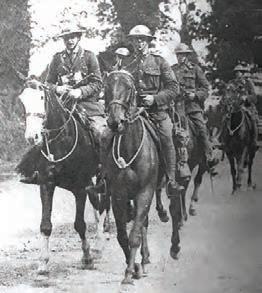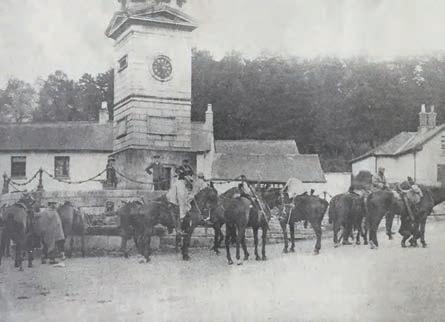
5 minute read
Enniskerry 1916–22 — Brian White
ENNISKERRY – Brian White
Enniskerry 1916–22
Advertisement
The Deane Oliver family
Richard Edward Deane Oliver, Royal Engineers, was killed in action at the Somme, 7 September 1916, in his 26th year. Richard was baptised in Powerscourt Church in 1890. His grandfather was Edward Falconer Litton, QC., who at the time lived at Valclusa, Enniskerry.
Richard was educated at Aravon in Bray and at Trinity College Dublin, where he graduated with a degree in Engineering. He gave up a job on the Manchester Ship Canal to take a commission in the Royal Engineers. He was killed instantly by a sniper while constructing a new line of trenches. He is remembered on the Roll of Honour in the Christ Church, Bray, at a memorial in Aravon and on the family grave in Powerscourt churchyard.
Losing Richard was only the beginning of the family’s troubles. Richard’s father, Charles Deane Oliver, who lived at Rockmills House, near Fermoy, Co. Cork, was Chief Engineer of the Department of Agriculture, and of the Congested Districts and Fisheries Boards. He was responsible for a great many of the harbours in the south and west of Ireland, and for opening up Arklow harbour in 1915. In 1919, the year he retired, Rockmills House was attacked by masked men, who shot him in both thighs. Then, in the spring of 1921, the IRA burnt Rockmills and the family, having lost everything except their lives, was forced to flee to England to live with relatives. They did return, however, to live productive lives in the new republic.
Charles Deane Oliver was born on 3 June 1861. He was the son of Richard Charles Deane Oliver and Katherine Hawtayne (d. 1911). He married Maria Charlotte Litton, daughter of Hon. Edward Falconer Litton, in 1888. He died on 6 February 1945 at age 83. He was educated at St. Columba’s College and at Trinity College.
Burial inscription of Richard Deane Oliver 1916, St. Patricks, Enniskerry. Photo: igb-web.com
Children of Charles Deane Oliver and Maria Charlotte Litton
1. Richard Edward Deane Oliver b. 21 Feb 1890, d. 7 Sep 1916 2. Elizabeth Catherine Deane Oliver b. 11 May 1895, d. 7 Aug 1953 3. Kathleen Maude Deane Oliver b. 15 Jan 1897 4. Silver Margaret Esther Deane Oliver b. 29 Jun 1899

British troops in Wicklow. Photo: Irish Life, 28 May 1920. Photo: By kind permission of the National Library of Ireland.
The War of Independence
» On 22 May 1919, Alfred Anderson, described as a Sinn Féiner from Sligo, was arrested in Enniskerry and returned to Sligo. A warrant for his arrest had been issued by the Sligo court for causing an unlawful assembly in Sligo.
» In 1920–21, gatherings of three or more people were banned in Ireland. There was also a curfew between 10 pm and 5 am. This curbed the social life of the village. Dance halls and public houses had to close early. The bus and rail companies had to re-arrange timetables and all services ceased at 9.30 pm.
» Locals in Enniskerry and environs raided equipment from road contractors, quarry tool sheds and local farms and dug trenches in the road to halt military motor cavalcades. There are recorded incidents of the military rounding up men to refill the trenches.

A cavalry patrol in Enniskerry. Photo: Courtesy of the National Library of Ireland - Irish Life, 28 May 1920
» The King’s Royal Hussars, based in Rathmines Barracks, Dublin, patrolled south County Dublin and north County Wicklow. Patrols started in Rathmines and included Rathfarnham, the Glencree valley, Enniskerry and Bray.
» In May 1921, a mail car was held up near Kilcroney. Intercepting mail cars yielded cash and money orders. In the period 1 January 1919 to 18 October 1920, a total of 741 raids on mail cars took place in Ireland.
» On 27 May 1921, the IRA attacked the RIC barracks in Enniskerry. (See
Henry Cairns, p. 59).
» In July 1921, two police constables were sitting in the coffee room of the
Powerscourt Arms hotel when shots rang out. One shot passed through the cap of a constable and grazed his forehead. Both constables returned fire but the assailant escaped unhurt.
» Several farmers in the area had haycocks and sheds set on fire, typically for one of three reasons: the rebels wanted to destroy any evidence they were
staying in a shed, the military found that the shed was used by the rebels and then destroyed it, the owner was passing information to the police or military. To this day, the specifics of each case remain unknown. » Lochner’s Pork Butchers of Bray was instructed to leave parcels of meat at the Silver Bridge on the Bray to Enniskerry Road. When Mr Lochner opened his shop a few days later, he discovered payment for the goods.
» In 1925, Eppels Film Ltd of Dublin made the film Irish Destiny, which depicts the War of Independence. One of the locations used for the film is Enniskerry village. It shows a group of dancers in front of the clock tower in the village and a raid by a Black & Tan unit.
Civil War
Lord Powerscourt allowed the military to camp on his estate. When the police barracks was destroyed by armed men on 8 July 1922, Lord Powerscourt claimed compensation and made the parish hall available as a temporary barracks.
In June 1922, a raid took place at Enniskerry post office. The postmistress Mrs Snow and her assistant Miss Byrne were unhurt. The raiders took £27 in cash and postal money orders. The cash box was found abandoned in Dalkey.
A second raid took place at the post office on 25 July 1922. Miss Byrne refused to give the raiders the keys and they fled without any cash. In December 1922, the postal authorities gave Miss Byrne a merit cheque for her bravery.
Raids also took place on farms and hardware stores and items stolen included shotguns and ammunition, foodstuffs and clothing. Raiders stole foodstuff from the shop of Michael Tallon of Enniskerry on 8 July 1922; they also took his motor car. Abraham Chatterton, who lived on the Powerscourt estate office on Kilgarron Hill, had his car stolen on 7 July 1922.










